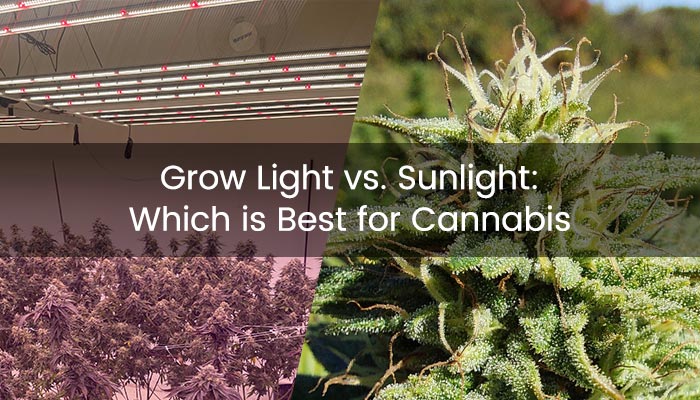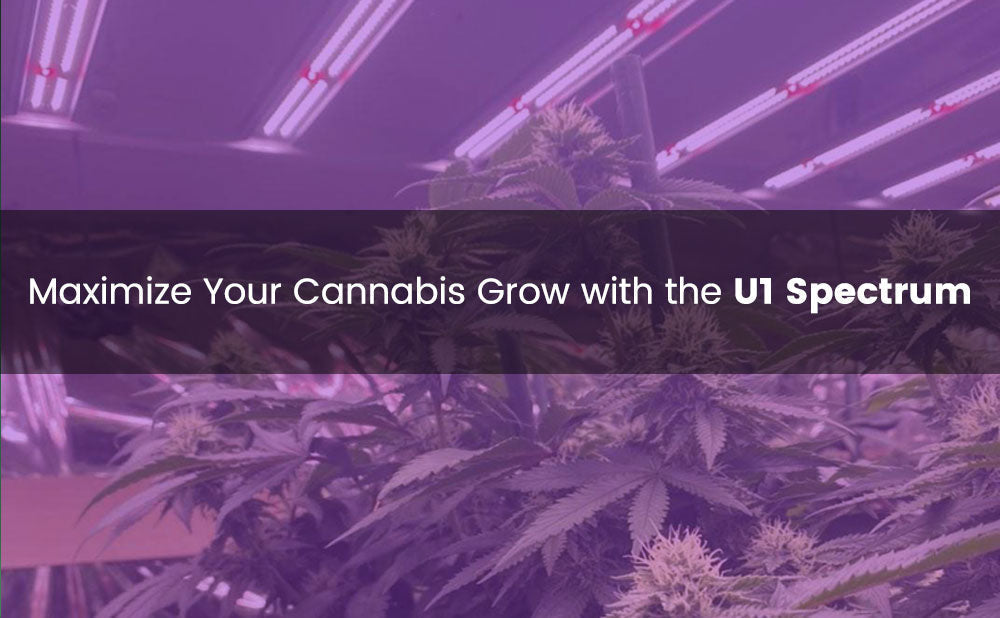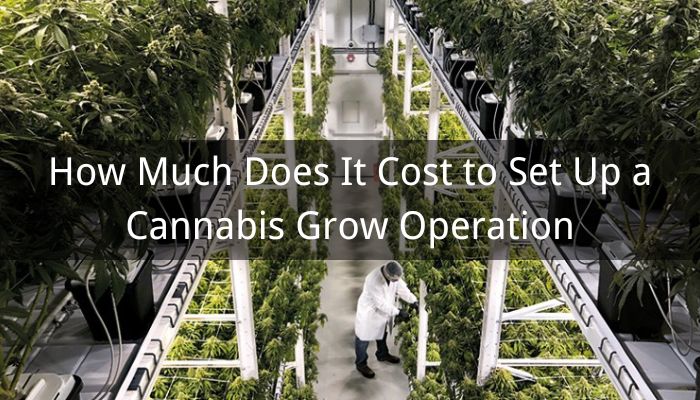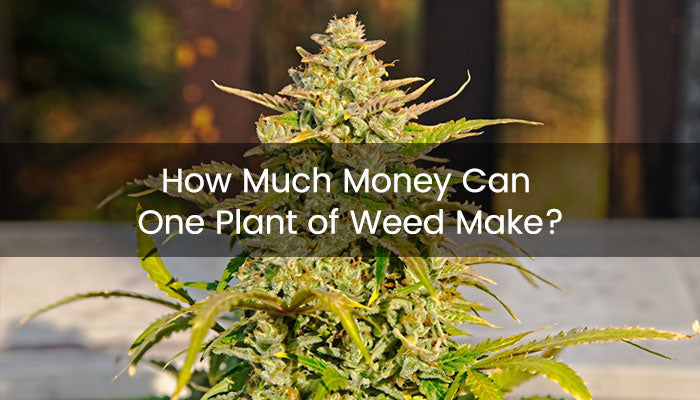We all know that cannabis is a light-loving plant, requiring a high daily light integral (DLI) and PAR (Photosynthetically Active Radiation) to thrive.
As indoor cannabis cultivation becomes increasingly popular, the debate over whether grow lights or sunlight is better has intensified.
In this guide, we will explore the advantages of grow lights over sunlight and how you can leverage these benefits to boost cannabis yield and quality.
Table of Contents:- A Comprehensive Comparison of Grow Lights vs. Sunlight
- Do Cannabis Grow Better in Sunlight or Grow Light
- LED Grow Lights and Commercial Cultivation
- 3 Key Advantages of Medic Grow Commercial Grow Lights
- Conclusion
A Comprehensive Comparison of Grow Lights vs. Sunlight
When it comes to cannabis cultivation, both grow lights and sunlight offer unique benefits, but they also have some limitations. Here’s a breakdown of how the two compare across key factors that influence plant growth.
Control and Consistency
One of the biggest advantages of grow lights is the ability to control the light environment. You can adjust the intensity, spectrum, and duration of light exposure to meet the specific needs of cannabis during different growth stages. This is particularly beneficial in areas with inconsistent sunlight or during seasons with shorter daylight hours.
In contrast, Sunlight provides a naturally balanced full spectrum, but it is less controllable. Factors like weather, seasons, and day length can impact how much sunlight your plants receive, making it less predictable for year-round growing.
Spectrum
When it comes to the spectrum, high-quality LED grow lights are designed to target the most beneficial wavelengths for cannabis growth, particularly in the blue and red parts of the spectrum.
Additionally, some LED lights also offer UV and IR light, which can enhance cannabinoid production and shorten the growth cycle. This flexibility allows growers to adjust the spectrum to optimize photosynthesis at different growth stages.
While natural sunlight provides full-spectrum light and is excellent for cannabis growth, indoor growers can effectively mimic and optimize specific light spectra with LED grow lights, focusing on wavelengths that promote growth and flowering and reducing energy costs.
Light Intensity
On a clear day, sunlight can deliver a Photosynthetic Photon Flux Density (PPFD) of 1,200–2,000 μmol/m²/s at midday. However, the intensity is unstable and varies throughout the day, influenced by factors such as weather, location, and seasons.
By contrast, high-quality LED grow lights can deliver consistent, adjustable light intensity tailored to each growth stage. Grow lights offer precise control, providing stable and optimized light levels regardless of outdoor conditions.

Energy Efficiency
In terms of energy efficiency, LED grow lights are highly energy-efficient and consume far less power than traditional lighting systems. However, the initial cost of purchasing high-quality lights can be substantial, and operating grow lights add to electricity expenses.
On the other hand, sunlight is a free and abundant energy source. Outdoor cultivation harnesses this natural resource without ongoing operational costs, but it is limited by environmental factors such as location, weather, and seasonal changes.
Yield and Quality
When comparing yield and quality, in controlled indoor environments, grow lights allow for year-round cultivation with optimized light cycles, which can lead to more consistent and predictable yields. By fine-tuning the light spectrum, growers can also increase the potency and quality of their crops.
Conversely, outdoor plants exposed to natural sunlight can grow larger and may produce higher yields due to the unrestricted space and the natural balance of light. However, the quality of outdoor crops can fluctuate based on unpredictable environmental conditions.
Environmental Factors
Regarding environmental factors, indoor growers using grow lights have complete control over the growing environment, including temperature, humidity, and CO2 levels. This control makes it easier to avoid pests, diseases, and harsh weather conditions, ensuring more consistent results.
In contrast, outdoor plants are subject to environmental fluctuations, which can increase the risk of pests, mold, and other challenges. However, they also benefit from natural CO2 levels and fresh air, which can improve plant health naturally.
Do Cannabis Grow Better in Sunlight or Grow Light
Both sunlight and grow lights can produce high-quality cannabis. Outdoor cultivation benefits from free, natural light and larger plant growth, but it is subject to environmental unpredictability.
Grow lights provide a more consistent and tailored light source, allowing for year-round cultivation and precise control, which can lead to higher potency and yields.
In controlled indoor environments, grow lights are generally better for consistent quality and maximizing yields, while sunlight is ideal for larger outdoor grows with lower operational costs, though more vulnerable to environmental risks.

LED Grow Lights and Commercial Cultivation
In commercial cannabis cultivation, whether in greenhouses or vertical farms, LED grow lights have become a key tool for increasing yields and optimizing the growing environment.
These lights break the limitations of seasons and daylight hours, providing consistent light that enables year-round cultivation. This ensures that plants can photosynthesize and grow in any season.
Additionally, in commercial cultivation, the light intensity (PPFD), spectrum, and exposure time of grow lights can be adjusted according to the specific growth stages of cannabis. For example, red and far-red light can accelerate the flowering phase, boosting yields and THC concentration.
Grow lights like the Medic Grow FOLD-800 U1 and FOLD-1200 U1 are specifically designed for the flowering stage of cannabis. They offer optimized red and far-red wavelengths with a PPF output of up to 3600 μmol/s, significantly promoting bud development and improving overall quality.
3 Key Advantages of Medic Grow Commercial Grow Lights
Medic Grow's commercial grow lights offer advanced features that help growers optimize their yields. Here are the three key advantages that set these lights apart.
Spectrum Tailored for Cannabis
Medic Grow Spectrum series offers an adjustable full spectrum specifically designed for cannabis cultivation.
Their V1 spectrum is ideal for the seedling and vegetative stages, with a balance of high blue light and adequate red light to encourage strong, healthy growth.
The F1 spectrum is rich in red light, perfect for the flowering stage to boost yield and THC levels.
For even more enhanced results, the VS spectrum adds UV and far-red light to the V1, while the FS spectrum includes UV and far-red light in the F1 for maximum potency and bud development.
High Energy Efficiency
Medic Grow LED grow lights are highly energy-efficient, providing powerful light output while consuming significantly less power than traditional grow lights.
For example, the FOLD-1200 delivers a remarkable PPF output of 3600 μmol/s, making it an unparalleled advantage in commercial cannabis cultivation.
This high-intensity light output ensures that plants receive optimal light levels, promoting faster growth, larger yields, and higher potency, which is critical for maximizing productivity in large-scale operations.
Free Grow Lights Through Rebates
All Medic Grow commercial grow lights are ETL and DLC certified, which means growers can qualify for massive rebates when purchasing these LED grow lights for commercial use.
With Medic Grow's support, you can get high-quality grow lights for free in bulk, allowing for a cost-effective way to scale up your commercial cannabis cultivation.
These benefits make Medic Grow Lights a top choice for commercial growers looking to optimize their yield, improve product quality, and minimize operational costs.
Conclusion
Both grow lights and sunlight have their advantages. If you're looking for year-round control, higher yields, and optimized growth conditions, high-quality LED grow lights like Medic Grow offer unmatched flexibility and performance. By effectively using them, you can ensure consistent, high-quality results.





